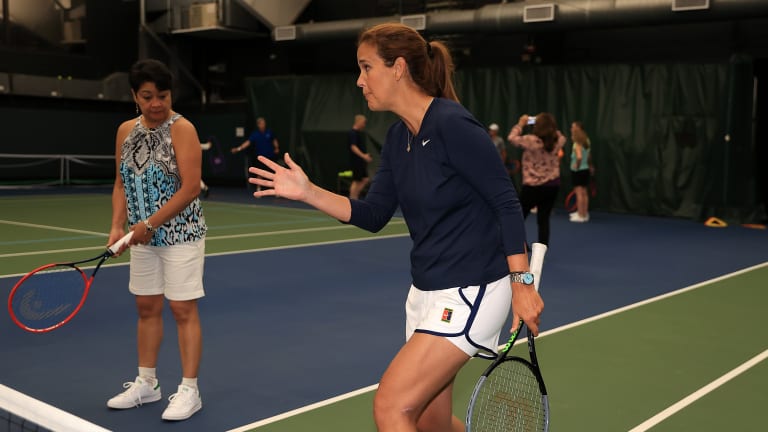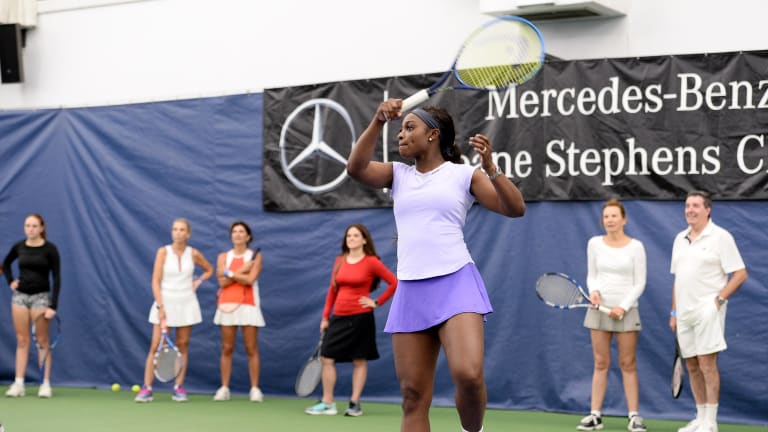Tennis Channel Academy: Is the Lesson Model Broken?
By Joel Drucker Oct 12, 2022Court of Appeals: Water Break
By Baseline Staff May 20, 2023Toni Nadal: With improved backhand, Casper Ruud "can be No. 1"
By Matt Cronin Nov 21, 2022Quick Tip: Add a rocking motion to the start of your serve
By Jon Levey Nov 16, 2022Tennis Channel Academy: Rectifying Road Rage
By Baseline Staff Oct 13, 2022Breaking The Rules: Time to abandon the net touch?
By Baseline Staff Oct 11, 2022Mission Transition: How to bring your game from baseline to net (Part 3 of 3)
By Jon Levey Oct 03, 2022Mission Transition: How to bring your game from baseline to net (Part 2 of 3)
By Jon Levey Oct 03, 2022What can be applied from Carlos Alcaraz, Casper Ruud to your game? How to enjoy the competitive process
By Joel Drucker Sep 12, 2022What recreational players can learn from Iga Swiatek, Ons Jabeur after US Open final
By Joel Drucker Sep 10, 2022Tennis Channel Academy: Is the Lesson Model Broken?
A deep dive into the transactional world of adult tennis instruction, and what needs to change.
Published Oct 12, 2022
WATCH: Talking Tennis With Tracy—Learning from Roger Federer
Advertising
The world of adult tennis instruction is marked by an education gap. Tennis teems with recreational players who never learn to serve with a proper grip, hit an overhead, drive a backhand—much less dissect an opponent and understand why they lost or even won a match.
Concurrently, all sorts of ill-informed concepts gain footholds in the minds of these enthusiastic players. In doubles, many players stand too close to the alley. Then there are those who dismiss opponents with such terms as “pusher,” rather than honestly acknowledge someone who is more consistent. Others believe that the key to becoming a better player is to simply hit the ball harder or compete versus better players, but have no idea why it’s usually best in a rally to hit crosscourt than down-the-line.
Where do these ideas come from? Why don’t teachers arrest them emphatically? Or do instructors inadvertently nurture this ignorance, be it by neglect or a fetish with technique and repetitive pace over tactics and variety? Why is it the case that a great many recreational players can hardly be bothered to take lessons? How best to assess tennis’ instructional model?
Certainly, there are lots of dedicated instructors. “One of my jobs is to help players see how tennis is a game of time and space and physics,” says Andrea Barnes, a coach based in the San Francisco Bay Area. “I want my students to learn what the entire court looks like.”
Every night, Atlanta-based coach Jim Harp asks himself, “Did we do it the right way?” And in the quest to sharpen her teaching methods, Denver-based Emma Doyle has studied the techniques of dozens of coaches in tennis and other disciplines.
Take time to question your pros. Find out why they’re asking you to do what they’re doing. A good pro can explain the reason why they’re having you do things. Gene Malin, tennis director at Bel Air Ridge
There are also devoted students. Larry Segan, a 4.5 player who lives in the New York City suburbs, will take as many as six lessons over the May through September outdoor tennis season. Amy Lundy, a Connecticut-based 3.5, participates in a range of clinics and private lessons.
“You’ve got to interview the adult first,” says veteran coach Lynne Rolley, chairman of the board of the Professional Tennis Registry, the worldwide organization of tennis coaches. “You’ve got to be honest about how much time and money they’re willing to put in, both during and away from the lessons.”
At the same time, it’s a two-way street. “Take time to question your pros,” says Gene Malin, tennis director at Bel Air Ridge, a facility in Los Angeles. “Find out why they’re asking you to do what they’re doing. A good pro can explain the reason why they’re having you do things.”
But to a great degree, the desire to play and the theoretical quest to get better tilt on a conflict between outcome and process. Judy Newman, a coach from Santa Cruz, Calif., believes that such results-heavy activities as league matches are a mixed blessing. “It’s great that you have the chance to compete,” she says, “but there’s also no time to refine your skills when what’s mostly on your mind is winning an upcoming team match.”
Alas, tennis’ collaborative competitive culture—be it leagues or even simply practice doubles matches—puts a clamp on the pursuit of improvement. Trot out that new topspin backhand in a singles tournament and you can miss it all day without anyone else paying the price for your education. But who wants to let down their partners or teammates as they struggle to master a new grip or swing?
Advertising

Mary Joe Fernandez during the UPS Tennis clinic at Boston Athletic Centre during Day 1 of the 2021 Laver Cup at TD Gardens.
© Getty Images for Laver Cup
There’s also the reality that lessons typically focus far less on tactics and more on stroke production—that is, how to hit the ball. It’s one thing to hit a shot proficiently when it’s fed comfortably on a platter. All becomes very different at 3-all in the third. At those moments, the teaching court might just as well be on the North Pole, a precious igloo far removed from the red-hot and sobering cauldron of match play.
But as both students and teachers point out, the very nature of the instructional business model—usually a compensated private lesson—makes it difficult for teachers to watch their students compete and closely study where that player’s game truly breaks down (or holds up). Rarely does one hear tales of two students sharing a lesson and playing a practice match in front of their coach. But when this does happen, students gain tremendous insights. “It’s great to help players learn to notice patterns,” says Barnes.
Anyone who’s ever taken a lesson has likely been asked this question: What do you want to work on? But as many players have told me over the years, there’s a tendency to answer reactively, reflecting simply on the one shot that broke down in their most recent match. Where’s the nuance in that? Can the student really self-diagnose? As Doyle says, “It’s better to ask these kinds of questions: Can you tell me three things you did well in your latest match? What are two areas you want to develop? What was the score of that match? What did you learn?”
Doyle also believes that not enough instructors focus on enhancing a player’s strengths. Says Malin, “You’ve got to know how to not give people too much information.”

Sloane Stephens hosts a private Tennis clinic with Mercedes-Benz before the 2019 US Open.
© 2019 Getty Images
Advertising
As tennis has grown, many more instructional methods have emerged. The clinic is a hybrid mix of movement, point play, and instruction. Cardio tennis is all about exercise. Group doubles lessons focus on strategic pointers.
“These activities can all be programmed and scheduled,” says Rolley, “just like an exercise class.” They’re also far less detail-oriented than taking a deep dive into the shape of a backhand swing, lazy footwork on the volley, poor body rotation when serving.
“People play tennis for all sorts of reasons—exercise, relieve stress, hang out with their buddies,” says Steve Contardi, director of tennis and operating partner at The Club at Harper’s Point, located in Cincinnati. “Not everyone is that concerned about refining their skills.”
The growth of the Internet and cell phone cameras have also revolutionized instruction. Many students these days relish the chance to tape their strokes and even entire matches. Operating from upstate Pennsylvania, Ryan Reidy runs 2MinuteTennis.net and works with students all over the world. “The tennis court is not the best place to learn,” says Reid. “On a court, you have to learn, process, and execute at the same time. It’s easy to get overwhelmed. This doesn’t happen on Zoom.”
Other coaches find online video instruction a cesspool of conflicting ideas, shallow insights and hucksterism. “Most coaches are trying to give you the quick fix,” says Harp. “It can make you happy, but it will still break down.”
People play tennis for all sorts of reasons—exercise, relieve stress, hang out with their buddies. Not everyone is that concerned about refining their skills. Steve Contardi, director of tennis, operating partner at The Club at Harper’s Point
Reidy strongly believes video instruction works best when it’s combined with in-depth personal attention and follow-up. Indeed, for all the high energy, exertion and fun that accompanies various group activities, when it comes to refining a stroke, there remains nothing more intimate, functional and effective than a one-on-one interaction between student and teacher—as deeply detailed as taking a piano lesson.
But the truth is that a great many players decline to seek such input. Instead, they speak out both sides of their mouth. Many will stay they only play for fun, while concurrently seeking greater outcomes, be it more victories versus familiar opponents, a higher winning percentage in league play, the chance to play with better players. But all the while, they refuse to make any investment in education.
This is unfortunate. The recreational tennis world is also filled with stories of players who only compete, but constantly hit a wall on the skills front. Feeling burnt out, they soon leave tennis. Says Lundy, “If you’re a competitive player, you need to have a mix—lessons, clinics, match play. It’s up to the player to figure out the mix.”
As for the coaches: please watch your students compete more. You have nothing to lose but your ball-hoppers.